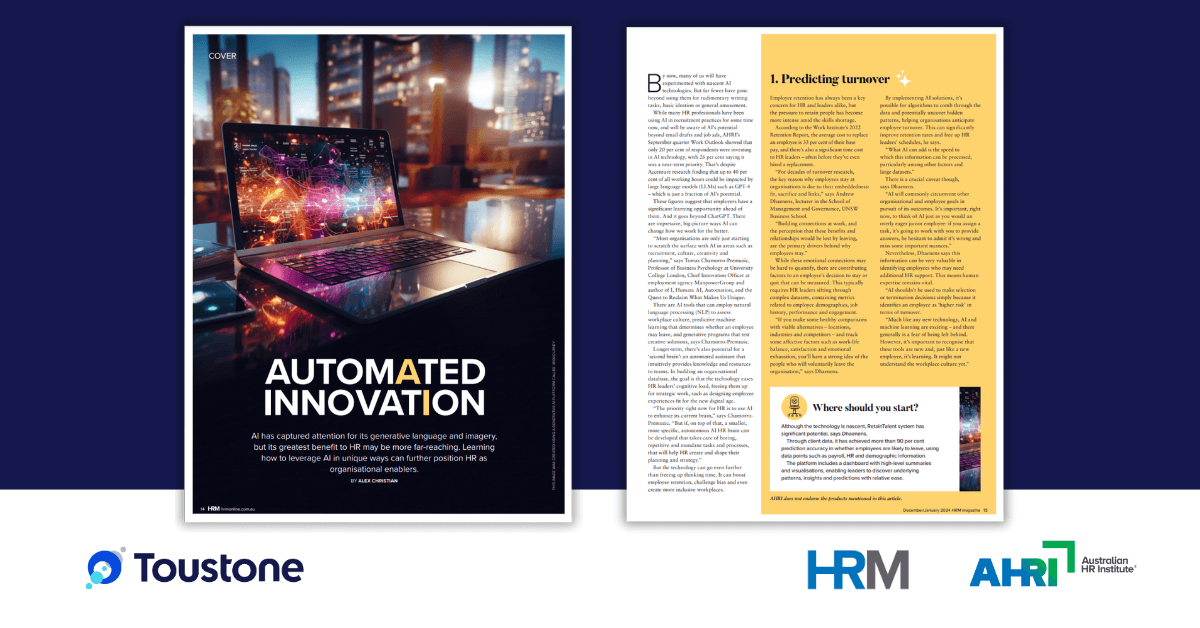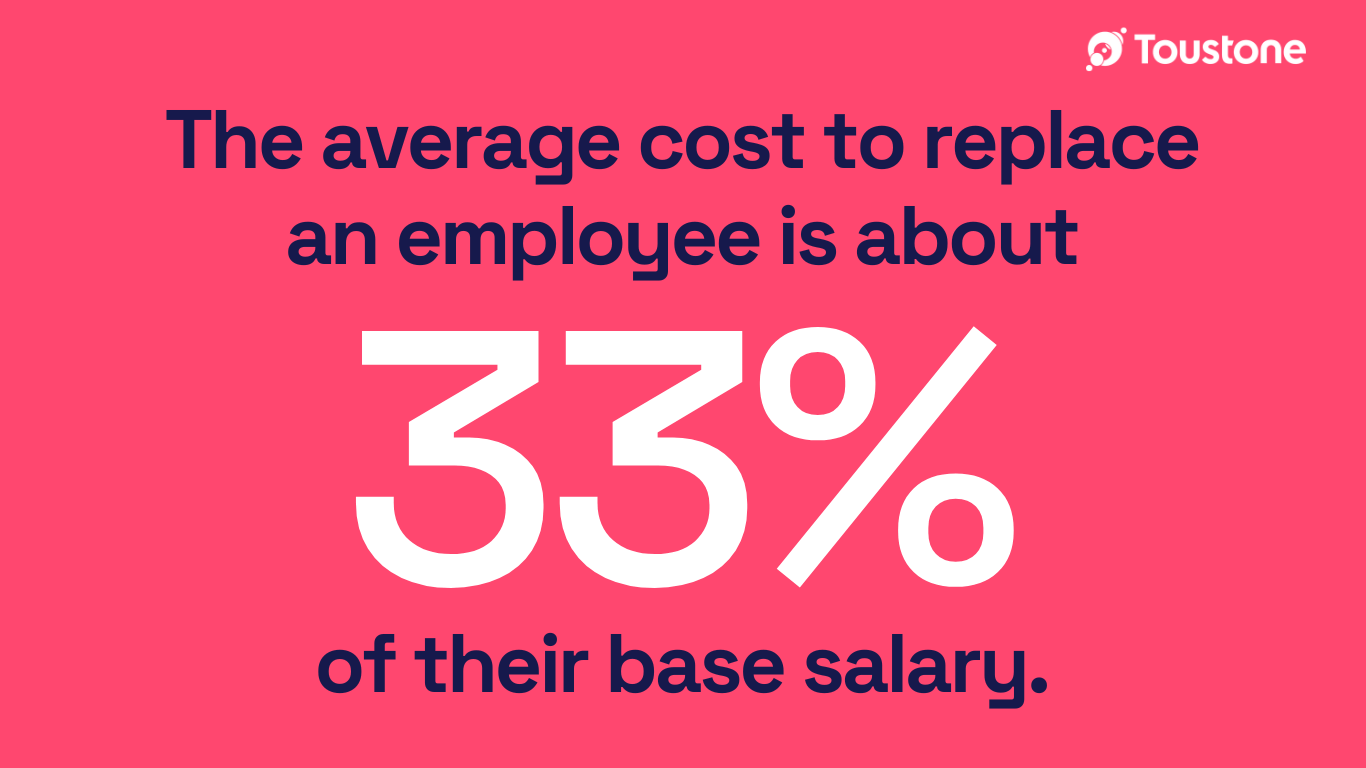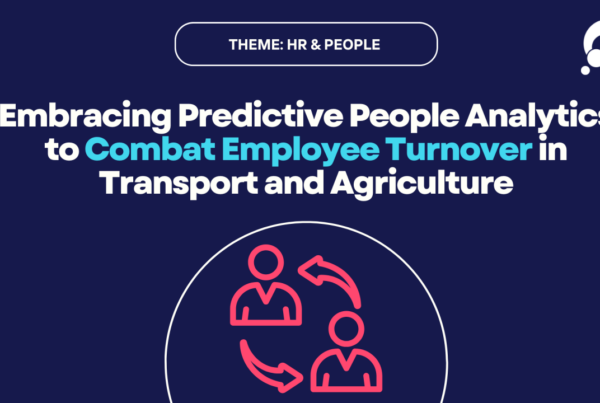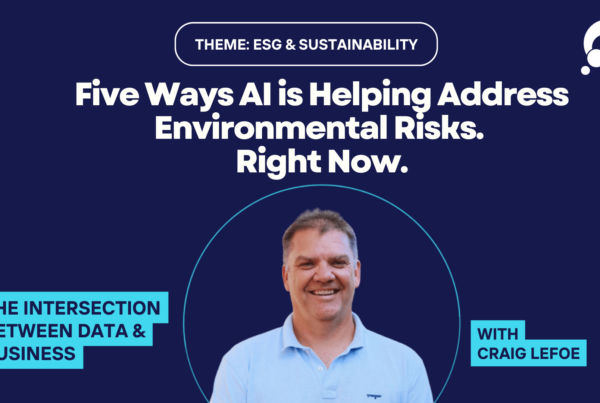
Author
Craig Lefoe, CEO
When it comes to technology, timing is everything.. You could have the most incredible game changing solution; yet the people you are pitching to are just not ready for it.
Take Generative AI for example, it’s become a household term probably since 2022, with the launch of ChatGPT, but it’s been around in some form for decades, some say since the 1960s. It makes me think of the many innovations launched in, say, the 2000s where it may have just been ‘too scary’ or ‘too weird’. Ultimately, the timing wasn’t right.
Is the timing right for Predictive People Analytics?
For a while there, I wasn’t too sure. But something big happened recently. Earlier this year, RetainTalent, our predictive people analytics platform, was mentioned by Lecturer Andrew Dhaenens from UNSW Business School in Australia’s leading HR institute’s (AHRI) HRM Magazine’s cover story titled ‘Automated Innovation’ as a go-to solution for businesses dealing with staff churn and retention challenges.
Before I get into the weeds of AI & predictive people analytics, I should also highlight it’s particularly flattering to be mentioned by Andrew, as he was part of a team between UNSW Business School’s Business AI Research Lab and Hybrid Work Leadership Research Lab who investigated RetainTalent’s user interface, predictive capabilities and the ethical framework, which Toustone used to develop RetainTalent (Read more about their independent process and learnings).
OK, back to the weeds. For me, it’s understandable why predictive people analytics is starting to gain traction among HR experts. And ultimately it comes down to problem solving. AI can help solve some major problems many businesses face. And the most common HR problem I hear about is employee retention.
How AI is being used to address employee turnover
First of all, is employee turnover really that big of a deal? I know you likely said YES! And the stats back this up. For example, the average cost to replace an employee is at about 33% of their base salary… and let’s not forget the time, HR resources and additional strain on productivity to fill the talent gap.

The thing is though, until now, there was really no way a HR leader, or business owner could accurately predict who may be at risk of leaving the company. Often, a manager will find out once a dreaded resignation letter hits their desk. Even if you have a highly emotionally intelligent operator who could pick up on potential ques, it would be guess work at best.
This is where AI, in the form of machine learning, is changing the game. For example, RetainTalent has been known to identify 87 per cent of staff who are planning on leaving in the next 12 months with a 96 per cent accuracy rate. This can be done at an individual, team and organisation level.

Just imagine knowing who is likely to leave, and better still, the likely reasons why. If you know, you can act. As Australian HR leaders and businesses put in measures to address these reasons, no doubt, the likelihood of losing that staff member will decrease.
No doubt its proven accuracy, and ethical design was part of the reason why RetainTalent was selected as a great place ‘to start’ (check out the screen shot from the article below) if you’re a business leader experiencing staff attrition you are not happy with, and want a data-driven solution to help you understand who is at risk of leaving and why.
In Andrew’s own words “Retain Talent has significant potential”. Potential to help you address your staff turnover. Potential to help you make sure you keep your best staff.

Beyond the data, connection is key
In the same cover article the author is quick to highlight the link between impactful emotional connections and employee retention.
“Building connections at work, and the perception that these benefits and relationships would be lost by leaving, are the primary drivers behind why employees stay.”
shared Andrew Dhaenens, Lecturer at UNSW Business School.
And though we are 100 per cent data people at Toustone, something that was absolutely clear from my decades of leadership, coupled with my involvement with RetainTalent is that intrinsic motivators are indeed difficult to quantify in data.
Yes, we can measure specific data metrics that contribute to the overall risk level of an employee leaving, but let’s not ever forget the importance of effective leadership and the “human element,” as we move into an AI-integrated business environment.
AI will continue to change how we work
As the author of the HRM cover story, Alex Christian, rightly points out, whether we like it or not, “AI is changing how we work.” This sentiment is rapidly being applied across almost all elements of a business, so it’s a matter of leveraging data to your advantage, working with the data, and using it for better.
And seasoned HR and recruitment specialist Will Howard agrees. He recently shared:
“Not only do HR executives now have the capacity to review vast sums of historical data and real-time data in dashboards, but by utilising cutting edge Machine Learning techniques, they can now also see into the future!
RetainTalent is a primary example of how Predictive People Analytics is changing the landscape for HR decision makers. Allowing it to become part of the way we work drastically reduces staff attrition. Post-COVID, that’s been every HR executive’s biggest problem.”
So whether you’re a HR professional trying to get on top of your staff attrition, or a business owner who wants to be on the front foot and avoid losing your best staff, then know there are solutions out there. Tried and tested ones. Like RetainTalent, our Predictive People Analytics Platform.
So please feel free to reach out to us as we’d be happy to explain how our machine learning experts and data scientists are ethically leveraging AI when it comes to staff retention with RetainTalent.
Sources
1. Work Institute’s 2022 Retention Report
2. Automated Innovation, Alex Christian, HRM Magazine Dec/Jan 2024




